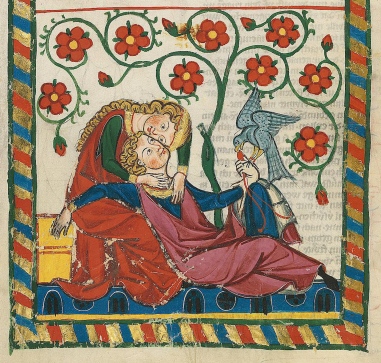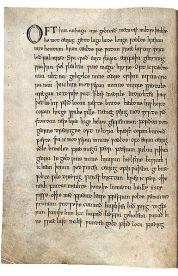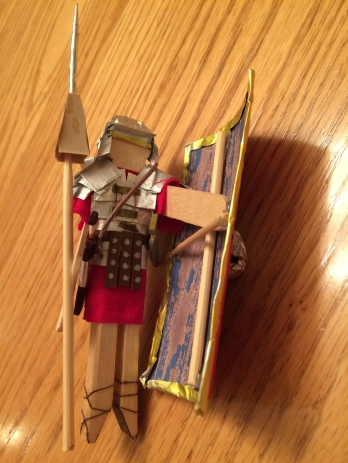“…they all march without noise, and in a decent manner, and every one keeps his own rank, as if they were going to war. The footmen are armed with breastplates and head-pieces, and have swords on each side; but the sword which is upon their left side is much longer than the other, for that on the right side is not longer than a span…”
-Flavius Josephus
Side Note:
I originally intended to create more than one model soldier, and I wanted to represent different time periods and locations we have discussed (a Greek hoplite, an English longbowman, and a Persian soldier were in the works). However, I underestimated the amount of time it takes to create one with this level of detail and consideration to historical accuracy. Ultimately, I decided to go for quality over quantity, so my project will focus only on the Roman legionary.
Overview
Holding true to my blog username, I created a mediocre legionary. The body was made with a wood clothespin (the old kind that doesn’t have a spring) and a popsicle stick cut in half for arms. The finished model stands roughly 4 inches tall (5.5 with the pilum) and has weapons and armor that match as closely as I could to those carried by a typical legionnaire around the first century CE. I heavily based my model after what I observed in pictures of the Ermine Street Guard, because of their quantity of useful pictures and very high reputation for historical accuracy (“The Ermine Street Guard”). The main components of his outfit are the tunic, helmet, body armor, belt and boots, shield, sword and dagger, and javelin.
Tunic

The typical legionary’s tunic would be made out of wool, and while it is uncertain which colors were used, red and white seem to be the most widely accepted. Interestingly, the only groups of people who exposed their knees in ancient Rome were soldiers and slaves (“Roman Arms and Armour”).
First, I had to create the soldier’s tunic. I used red cotton fabric that I had cut into rectangle. Folding it in half to maintain symmetry, I cut a hole for the head and arms and then sewed the seams along the sides to basically make a T-shirt.
Helmet
Roman helmets were typically made out of iron, but other materials such as copper, brass, and bronze have been found to have also been used (“Roman Arms and Armour”). The Gallic design and craftsmanship were highly favored among soldiers; generally being preferred over the Italian models by the Roman army (Matyszak, 59). The average legionary would only have a plume on top of his helmet during special parading events, which I why I left it off (Matyszak, 59). Helmets, along with some other gear, have been found baring inscriptions with the name of its owner; a very interesting historical point as it shows the ownership of the helmet being passed from soldier to soldier within a unit. This also indicates personal, not military, ownership of some armor and equipment (Nicolay, 168).
The helmet was the most frustrating part to create, which is why I do not have any pictures of the process. I put a base piece of tin foil around the head and then glued the cheek pieces (which were paper rectangles wrapped in paper) to the sides of the face. I then made a tin foil ball to put on top of the head to give the helmet a round shape, and then covered that with another piece of tin foil to give it a smoother texture. Next, I placed a semi-circle of paper wrapped tin foil on the back of the head to serve as the neck guard. I finished by adding the cross brace to the front and coloring the bottom with a yellow sharpie to simulate the embellishments of a real helmet.
Body Armor
Lorica segmentata was highly effective body armor used by the Roman army during the first century CE. It was flexible and lightweight, but also very difficult to maintain since the iron tended to corrode when exposed to water, sweat, or blood- things a soldier would frequently encounter (Matyszak, 56).
To start, I wrapped strips of paper with tin foil, as tin foil alone crumpled too easily, looked messy, and was not sturdy enough to support the weight of the armor. After measuring out the strips and wrapping them around the body, I glued them together trying to follow the look of the real armor as closely as possible. Once the structure was stabilized, I cut the armor down the middle (the short pieces were too difficult to manipulate) and secured them with glue. The lorica segmentata was finished with gold pieces of paper and embroidery floss resembling the various straps and fasteners that were used to attach the armor to the soldier.
Belt and Boots
The Roman legionary’s belt was generally made of leather and copper alloy plating that was embossed or adorned with tin wash or silver plating. It served both as protection from hits below the belt and as a convenient place to hold the sword and/ or dagger. Sometimes separate belts were worn so the sword was attached to one with the dagger on the other to more evenly distribute weight (“Roman Arms and Armour”).
Their boots/ sandals, also called caliga, were cut from a single piece of leather and closely resemble modern athletic shoes with how they optimize the weight distribution around the foot (“Roman Arms and Armour”). The bottoms the caliga featured sharp hobnails, which were useful for traction and combat (Matyszak, 53-54).
I created the belt with brown construction paper and used a silver marker to show the metal plates. The soles of the caliga were also made with the same paper and marker (this time used to represent hobnails), and the tops were made with embroidery floss.
Shield
The scutum was the most widely used shield by the Roman army during this time. It was a large, curved rectangle shape that was made from gluing three layers of wood together and covering them with leather and canvas and metal edging. It was normally generally red with yellow decorations of thunderbolts and eagle wings. It was approximately 3.5 feet tall, 16 inches wide, and 5-6 millimeters thick. This was a highly effective shield as it was light enough to be carried by one arm, and large enough to cover the entire soldier, but was eventually replaced as their enemies’ weapons became strong enough to cut through it (“Scutum”). The curved shape of the shield enabled the Roman soldiers to create a testudo, or tortoise formation, which completely protected the soldiers and allowed them to use their spears through the gaps. The shield would also have a strap that allowed it be carried over the back while marching.
I created my shield by drawing and coloring the design on a piece of paper, gluing that to a thin piece of cardboard, gluing a piece of wood patterned paper on the other side, and curling it while still wet around a can. Then I added the tin foil embellishments to the front (the ball is a pom-pom covered in tin foil), the foil along the sides (colored with a yellow marker), and finished by gluing the wood sticks to the inside.
This slideshow requires JavaScript.
Sword and Dagger
The sword carried by the Roman legionary, called a gladius, was a short blade (usually no more than 2 feet long) and was very popular during the time. The more general term for a sword, spatha, could also be used here, but it generally associated with a longer sword that became more popular in the 2nd and 3rd centuries. It was a highly effective weapon that was used by the Roman military for nearly 6 centuries (“Roman Military Personal Equipment”). As described by Flavius Josephus, Roman soldiers carried their longer sword on their left side (Josephus). This was a later trend, as legionnaires originally carried their gladius on their right, and only centurions and cavalrymen carried swords on their left; something the infantry eventually did as well (“Roman Arms and Armour”). The sword was often carried on the belt, but many of the reenactment photos I researched were shown with a cross-body strap supporting the heavier sword. The gladius was generally employed in a stabbing technique, and the shape of the sword required a twisting motion to be withdrawn (Matyszak, 62-63).
The soldier’s dagger, a pugio, was a leaf shaped blade, usually 7-12 inches long, and was most likely used as a sidearm (“Roman Military Personal Equipment”). Personal preference resulted in a variety of pugio, with some being more functional while others were elaborately sheathed with decorations and precious metals (“Roman Arms and Armour”).
My model’s gladius is shown in a sheath and was made from foam I’d colored brown with a marker and part of a toothpick used for a hilt. I wrapped a piece of tin foil around the middle to show what would actually be an embellished metal plate on the outside of the sheath. The pugio was made with the same method, but unsheathed and much shorter than the gladius.
Javelin
The final weapon carried by the legionary was his pilum, or javelin. This was a very long and heavy weapon, spanning some 6 feet in length and weighing 4.5-9 pounds, sometimes with the addition of a lead ball for added weight (“Roman Military Personal Equipment”; Matyszak, 65). The shank was made of iron and the shaft was usually made with ash, or similar wood (Matyszak, 65). If thrown correctly, it could penetrate both the shield and armor of its target; but if it got stuck in the shield only, it would be very difficult to remove since the shank would bend and break off from the shaft on impact (“Roman Military Personal Equipment”). Unlike a traditional spear, the pilum was designed for only one use in battle (enemies could not reuse it against them) and was not able to function as some of the other tools, such as a walking stick or stretcher, that a typical spear could because of its points on both ends and fragile nature. Its heavy weight also made it cumbersome to carry on march (Matyszak, 64-66).
The pilum held by my model is a little on the short side, and does not have a pointed tip on the bottom because I may have glued it together the wrong way… My shaft is made of a kebab skewer, the shank is a toothpick wrapped in tin foil, and the base of the shank is tan paper.
Finished Product


Works Cited
“A Beginner’s Guide to Roman Arms and Armour.” Armamentarivem. Museum of Antiquities, 24 May 1997, https://web.archive.org/web/20081219110103/http://museums.ncl.ac.uk:80/archive/arma/welc/beginner/page00.htm. Accessed 5 December 2018.
Dowson, Thomas. “Archaeology from Roman Corbridge Comes Alive at Chesters Roman Fort.” Archaeology Travel, archaeology-travel.com/artefacts/archaeology-from-roman-corbridge-comes-alive-at-chesters-roman-fort/. Accessed 13 December 2018.
Flavius Josephus: The Jewish War. III.5-6, trans. William Whiston. “Internet Medieval Sourcebook”, Halsall, Paul, Fordham University, 4 November 2011, sourcebooks.fordham.edu/ancient/josephus-warb.asp. Accessed 13 December 2018.
MatthiasKabel. “File:Helmet typ Weissenau 01.jpg.” Wikipedia Commons, 23 June 2007. commons.wikipedia.org/w/index.php?title=File:Helmet_typ_Weissenau_01.jpg&oldid=293926243. Accessed 14 December 2018.
Matyszak, Philip. Legionary The Roman Soldier’s (Unofficial) Manual. London, Thames & Hudson Ltd, 2009, pp. 52-66, 81-88, 137-146.
Nicolay, Johan. “Military Equipment and the Life Cycle of a Roman Soldier.” Armed Batavians: Use and Significance of Weaponry and Horse Gear from Non-Military Contexts in the Rhine Delta (50 BC to AD 450), Amsterdam University Press, Amsterdam, 2007, pp. 157–206. JSTOR, http://www.jstor.org/stable/j.ctt46n2g3.8. Accessed 13 December 2018.
The Ermine Street Guard. The Ermine Street Guard, http://www.erminestreetguard.co.uk. Accessed 14 December 2018.
Wikipedia contributors. “Roman military personal equipment.” Wikipedia, The Free Encyclopedia. Wikipedia, The Free Encyclopedia, 13 Dec. 2018, en.wikipedia.org/wiki/Roman_military_personal_equipment. Accessed 14 December 2018.
Wikipedia contributors. “Scutum (shield).” Wikipedia, The Free Encyclopedia. Wikipedia, The Free Encyclopedia, 15 Nov. 2018, en.wikipedia.org/wiki/Scutum_(shield). Accessed 14 December 2018.





 However, I would disagree that kin altruism is the main driving force for Beowulf’s heroism. Beowulf is the great warrior that he is because he was seeking to become the next king of his people. Which eventually he did achieve, “This he laid on Beowulf’s lap and then rewarded him with land as well, seven thousand hides; and a hall and a throne” (Beowulf 89). In the Anglo-Saxon society, the king was not based on blood-line, but on merit. Whoever fought the hardest and showed their worth became the next king. This is precisely why Beowulf completes his heroic feats. This reasoning behind his heroism also fits with the Anglo-Saxon definition of what a hero is that is found in the poem “The Wanderer.”
However, I would disagree that kin altruism is the main driving force for Beowulf’s heroism. Beowulf is the great warrior that he is because he was seeking to become the next king of his people. Which eventually he did achieve, “This he laid on Beowulf’s lap and then rewarded him with land as well, seven thousand hides; and a hall and a throne” (Beowulf 89). In the Anglo-Saxon society, the king was not based on blood-line, but on merit. Whoever fought the hardest and showed their worth became the next king. This is precisely why Beowulf completes his heroic feats. This reasoning behind his heroism also fits with the Anglo-Saxon definition of what a hero is that is found in the poem “The Wanderer.” The definition given here can be directly attributed to what makes a good soldier because the poem was originally used as a rallying device to get soldiers ready to go into battle. This poem has been preserved in the Exeter Book, the largest surviving container of Anglo-Saxon poetry, which dates back to 975. A picture of the poem from this book is given to the right (Muir). Although the book dates back to 975, the poem of “The Wanderer” may be much older (Greenblatt 119). According to this poem, a true hero has these characteristics,
The definition given here can be directly attributed to what makes a good soldier because the poem was originally used as a rallying device to get soldiers ready to go into battle. This poem has been preserved in the Exeter Book, the largest surviving container of Anglo-Saxon poetry, which dates back to 975. A picture of the poem from this book is given to the right (Muir). Although the book dates back to 975, the poem of “The Wanderer” may be much older (Greenblatt 119). According to this poem, a true hero has these characteristics,














![675px-Helmet_typ_Weissenau_01 CC BY 2.5 (https://creativecommons.org/licenses/by/2.5)]](https://legioilynx.files.wordpress.com/2018/12/675px-Helmet_typ_Weissenau_01.jpg?w=162&resize=162%2C217&h=217#038;h=217)















